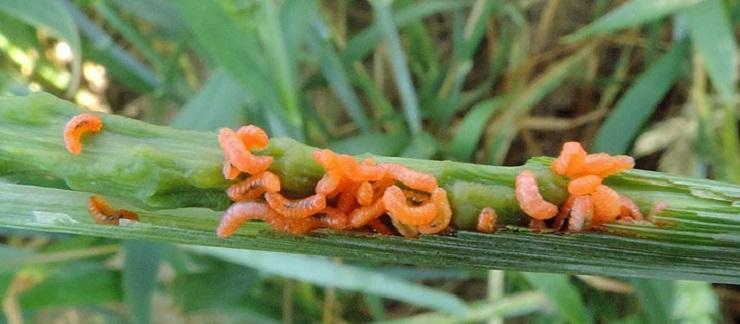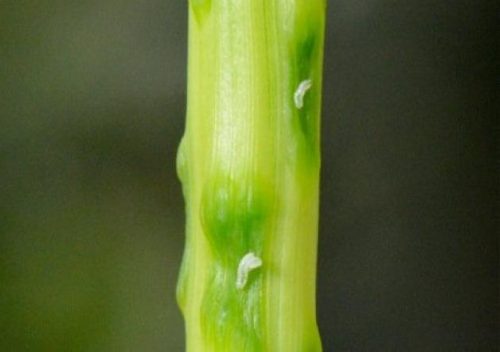Saddle gall midge (Haplodiplosis marginata) – pest management

The saddle gall midge, Haplodiplosis marginata, is a species reported to be harmful to cereal crops in several European countries.
Description. The adult has a dark body, black head, and chest, and the scutellum is yellow. The abdomen has reddish hues. The body is 4-5 mm long, the female being larger than the male. The wings are transparent and display iridescences. The eggs are 0.3×0.8 mm and are reddish in color. The larva is 3-4 mm long, doesn’t have any feet. It is eucephalous and colored in red.
Biology and ecology
The saddle gall midge produces only one generation per year and overwinters as a fully developed larva in the soil. The larvae have the ability to remain in the ground, in a state of hibernation, for several years, if there are no favorable conditions for pollination in April-June.
In April-May, the larvae rise to the surface of the soil to pupate. After 4-5 days the adults appear and soon the copulation and egg-laying take place. A female lays about 200 eggs, in groups of 15-20 eggs, usually on the upper leaves, along the ribs, and on the pod. The eggs are sensitive to dryness. After hatching, the larvae penetrate the foliar limb and stem of the plant, spreading along the internode. Up to 100 larvae can be found on a stem. Before the grain is harvested, the larvae complete their development and descend into the soil for the summer diapause, which then continues with their overwintering.
The high humidity of the air and the soil, the monoculture, and the heavy soils favor the development and breeding of the saddle gall midge.
Attacked plants and damages
The saddle gall midge infests several species of grasses, but prefers wheat and barley and likes less rye and oats. The attacked plants have the petiole of the leaves swollen at the place where the larvae are attached. In these elongated swellings, there are numerous galls full of red larvae in different stages of development. In the attacked areas, the straw has the xylem and the phloem destroyed, which causes the crops’ development to slow down, stagnation, and premature ripening. The attack of this pest reduces the height of the plant and the length of the spike, resulting in undeveloped spikes, with a small number of grains or even sterile.
Control
The appearance of this pest is favored by the cultivation of wheat in monoculture, the existence of clay soils, and high atmospheric and soil humidity. Crop rotation reduces the pest population.
Chemical treatments have to be applied when the biological reserve is 30-50 larvae/m². It is recommended to apply 3 treatments during the vegetative growth period. The first treatment gas to be done when most adults start flying, followed by 2 more treatments, at intervals of 8-10 days.
The treatments must be performed with specific insecticides.
Recommended products
-
You can find products on a different store
Change Store -
You can find products on a different store
Change Store -
You can find products on a different store
Change Store -
You can find products on a different store
Change Store -
You can find products on a different store
Change Store -
You can find products on a different store
Change Store -
You can find products on a different store
Change Store -
You can find products on a different store
Change Store -
You can find products on a different store
Change Store -
You can find products on a different store
Change Store -
You can find products on a different store
Change Store -
You can find products on a different store
Change Store -
You can find products on a different store
Change Store -
You can find products on a different store
Change Store -
You can find products on a different store
Change Store -
You can find products on a different store
Change Store -
You can find products on a different store
Change Store -
You can find products on a different store
Change Store -
You can find products on a different store
Change Store -
You can find products on a different store
Change Store -
You can find products on a different store
Change Store -
You can find products on a different store
Change Store -
You can find products on a different store
Change Store -
You can find products on a different store
Change Store

















































































































































































































































































































































































































































